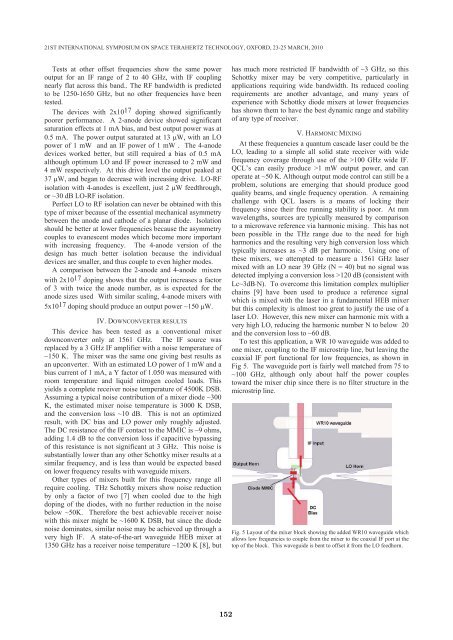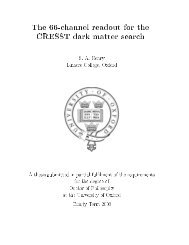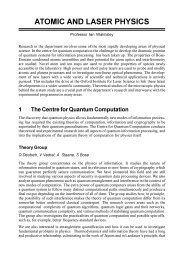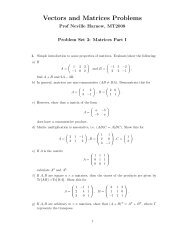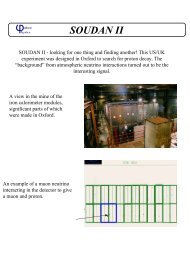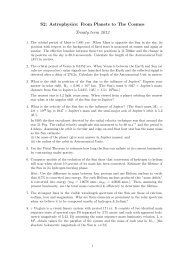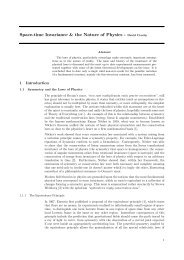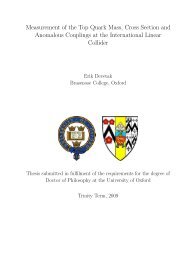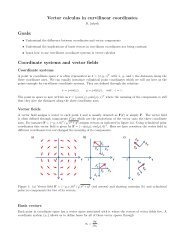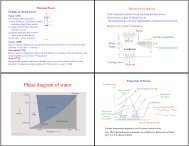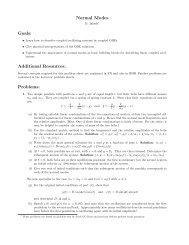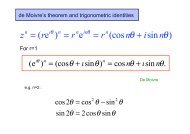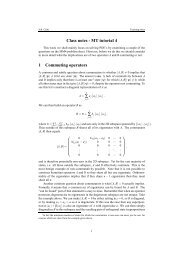Session S6: Schottky Diodes and Mixers - Department of Physics
Session S6: Schottky Diodes and Mixers - Department of Physics
Session S6: Schottky Diodes and Mixers - Department of Physics
Create successful ePaper yourself
Turn your PDF publications into a flip-book with our unique Google optimized e-Paper software.
21ST INTERNATIONAL SYMPOSIUM ON SPACE TERAHERTZ TECHNOLOGY, OXFORD, 23-25 MARCH, 2010<br />
Tests at other <strong>of</strong>fset frequencies show the same power<br />
output for an IF range <strong>of</strong> 2 to 40 GHz, with IF coupling<br />
nearly flat across this b<strong>and</strong>.. The RF b<strong>and</strong>width is predicted<br />
to be 1250-1650 GHz, but no other frequencies have been<br />
tested.<br />
The devices with 2x1017 doping showed significantly<br />
poorer performance. A 2-anode device showed significant<br />
saturation effects at 1 mA bias, <strong>and</strong> best output power was at<br />
0.5 mA. The power output saturated at 13 W, with an LO<br />
power <strong>of</strong> 1 mW <strong>and</strong> an IF power <strong>of</strong> 1 mW . The 4-anode<br />
devices worked better, but still required a bias <strong>of</strong> 0.5 mA<br />
although optimum LO <strong>and</strong> IF power increased to 2 mW <strong>and</strong><br />
4 mW respectively. At this drive level the output peaked at<br />
37 W, <strong>and</strong> began to decrease with increasing drive. LO-RF<br />
isolation with 4-anodes is excellent, just 2 W feedthrough,<br />
or ~30 dB LO-RF isolation.<br />
Perfect LO to RF isolation can never be obtained with this<br />
type <strong>of</strong> mixer because <strong>of</strong> the essential mechanical asymmetry<br />
between the anode <strong>and</strong> cathode <strong>of</strong> a planar diode. Isolation<br />
should be better at lower frequencies because the asymmetry<br />
couples to evanescent modes which become more important<br />
with increasing frequency. The 4-anode version <strong>of</strong> the<br />
design has much better isolation because the individual<br />
devices are smaller, <strong>and</strong> thus couple to even higher modes.<br />
A comparison between the 2-anode <strong>and</strong> 4-anode mixers<br />
with 2x10 17 doping shows that the output increases a factor<br />
<strong>of</strong> 3 with twice the anode number, as is expected for the<br />
anode sizes used With similar scaling, 4-anode mixers with<br />
5x1017 doping should produce an output power ~150 W.<br />
IV. DOWNCONVERTER RESULTS<br />
This device has been tested as a conventional mixer<br />
downconverter only at 1561 GHz. The IF source was<br />
replaced by a 3 GHz IF amplifier with a noise temperature <strong>of</strong><br />
~150 K. The mixer was the same one giving best results as<br />
an upconverter. With an estimated LO power <strong>of</strong> 1 mW <strong>and</strong> a<br />
bias current <strong>of</strong> 1 mA, a Y factor <strong>of</strong> 1.050 was measured with<br />
room temperature <strong>and</strong> liquid nitrogen cooled loads. This<br />
yields a complete receiver noise temperature <strong>of</strong> 4500K DSB.<br />
Assuming a typical noise contribution <strong>of</strong> a mixer diode ~300<br />
K, the estimated mixer noise temperature is 3000 K DSB,<br />
<strong>and</strong> the conversion loss ~10 dB. This is not an optimized<br />
result, with DC bias <strong>and</strong> LO power only roughly adjusted.<br />
The DC resistance <strong>of</strong> the IF contact to the MMIC is ~9 ohms,<br />
adding 1.4 dB to the conversion loss if capacitive bypassing<br />
<strong>of</strong> this resistance is not significant at 3 GHz. This noise is<br />
substantially lower than any other <strong>Schottky</strong> mixer results at a<br />
similar frequency, <strong>and</strong> is less than would be expected based<br />
on lower frequency results with waveguide mixers.<br />
Other types <strong>of</strong> mixers built for this frequency range all<br />
require cooling. THz <strong>Schottky</strong> mixers show noise reduction<br />
by only a factor <strong>of</strong> two [7] when cooled due to the high<br />
doping <strong>of</strong> the diodes, with no further reduction in the noise<br />
below ~50K. Therefore the best achievable receiver noise<br />
with this mixer might be ~1600 K DSB, but since the diode<br />
noise dominates, similar noise may be achieved up through a<br />
very high IF. A state-<strong>of</strong>-the-art waveguide HEB mixer at<br />
1350 GHz has a receiver noise temperature ~1200 K [8], but<br />
has much more restricted IF b<strong>and</strong>width <strong>of</strong> ~3 GHz, so this<br />
<strong>Schottky</strong> mixer may be very competitive, particularly in<br />
applications requiring wide b<strong>and</strong>width. Its reduced cooling<br />
requirements are another advantage, <strong>and</strong> many years <strong>of</strong><br />
experience with <strong>Schottky</strong> diode mixers at lower frequencies<br />
has shown them to have the best dynamic range <strong>and</strong> stability<br />
<strong>of</strong> any type <strong>of</strong> receiver.<br />
V. HARMONIC MIXING<br />
At these frequencies a quantum cascade laser could be the<br />
LO, leading to a simple all solid state receiver with wide<br />
frequency coverage through use <strong>of</strong> the >100 GHz wide IF.<br />
QCL’s can easily produce >1 mW output power, <strong>and</strong> can<br />
operate at ~50 K. Although output mode control can still be a<br />
problem, solutions are emerging that should produce good<br />
quality beams, <strong>and</strong> single frequency operation. A remaining<br />
challenge with QCL lasers is a means <strong>of</strong> locking their<br />
frequency since their free running stability is poor. At mm<br />
wavelengths, sources are typically measured by comparison<br />
to a microwave reference via harmonic mixing. This has not<br />
been possible in the THz range due to the need for high<br />
harmonics <strong>and</strong> the resulting very high conversion loss which<br />
typically increases as ~3 dB per harmonic. Using one <strong>of</strong><br />
these mixers, we attempted to measure a 1561 GHz laser<br />
mixed with an LO near 39 GHz (N = 40) but no signal was<br />
detected implying a conversion loss >120 dB (consistent with<br />
Lc~3dBN). To overcome this limitation complex multiplier<br />
chains [9] have been used to produce a reference signal<br />
which is mixed with the laser in a fundamental HEB mixer<br />
but this complexity is almost too great to justify the use <strong>of</strong> a<br />
laser LO. However, this new mixer can harmonic mix with a<br />
very high LO, reducing the harmonic number N to below 20<br />
<strong>and</strong> the conversion loss to ~60 dB.<br />
To test this application, a WR 10 waveguide was added to<br />
one mixer, coupling to the IF microstrip line, but leaving the<br />
coaxial IF port functional for low frequencies, as shown in<br />
Fig 5. The waveguide port is fairly well matched from 75 to<br />
~100 GHz, although only about half the power couples<br />
toward the mixer chip since there is no filter structure in the<br />
microstrip line.<br />
Fig. 5 Layout <strong>of</strong> the mixer block showing the added WR10 waveguide which<br />
allows low frequencies to couple from the mixer to the coaxial IF port at the<br />
top <strong>of</strong> the block. This waveguide is bent to <strong>of</strong>fset it from the LO feedhorn.<br />
152


